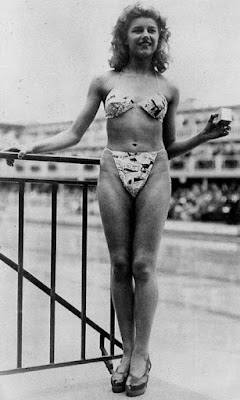THE DAY THE
BIKINI ARRIVED
G'day folks,
Millions of men would come to be grateful that Frenchman Louis Réard, a car mechanic, had an unlikely sideline in the 1940s – he also looked after his mother’s lingerie boutique in Paris. And from there he created the bikini, which was unveiled in 1946.
Up to that point, the most revealing bathing costume on the market
displayed a mere sliver of flesh at the midriff. A scornful Réard
thought women should be more daring, especially with a spirit of “doing
your own thing” taking hold across Europe after the chains of war had
finally been broken and people were beginning to enjoy a new taste of
freedom.
Adding to the pressure for change was the drive by clothing
manufacturers and designers to produce new ranges that would reflect the
free-spirited mood of the times.
Rising to the challenge, Réard created a bathing costume using no more
than 30 inches of fabric, the bottom half made basically from two
triangles of cloth held together with string and the top half no more
than a skimpy bra.
He thought the design would be “highly explosive” and, inspired by
American atomic bomb tests that had started to take place off the Bikini
Atoll in the Pacific Ocean, he cheekily called his swimwear “the
bikini”.
Now he needed to market it. But finding a model prepared to appear in
public wearing his scandalously skimpy creation proved to be quite a
challenge. Finally, he recruited 19-year-old exotic dancer Micheline
Bernardini who had no qualms at all about parading semi-naked for all to
see.
Expecting big headlines after the launch at a Paris swimming pool, Réard
designed a bikini for Micheline printed appropriately, as he thought,
with newspaper type.
Another French designer, Jacques Heim, had produced a competing swimsuit
which he called the “atom” and described it as “the world’s smallest
bathing suit.” But Réard’s creation was considerably smaller and he
advertised it as “smaller than the world’s smallest bathing suit.”
Shockingly for many people, it was also the first time that the wearer’s navel had been exposed.
There was a lot of initial resistance to the bikini; indeed it was
banned on beaches in Spain and Italy for a time and was considered
unacceptable in the United States. But more and more women wanted one
and they appeared in increasing numbers on Europe’s beaches as each
summer passed.
A significant breakthrough come in 1958 when Brigitte Bardot,
the so-called “sex kitten” of the age, exploded onto cinema screens
flaunting a bikini in her iconic film, And God Created Woman.
In the US, barriers were broken in 1960 when pop star Bryan Hyland
scored a major worldwide hit with a novelty number which told of his
girl dressed only in an “Itsy Bitsy Teenie Weenie Yellow Polkadot
Bikini.”
Louis Réard, who insisted that a two-piece wasn’t a genuine bikini
“unless it could be pulled through a wedding ring,” continued selling
them from his shop in Paris until 1980. He died in 1984 at the age of
88.


No comments:
Post a Comment